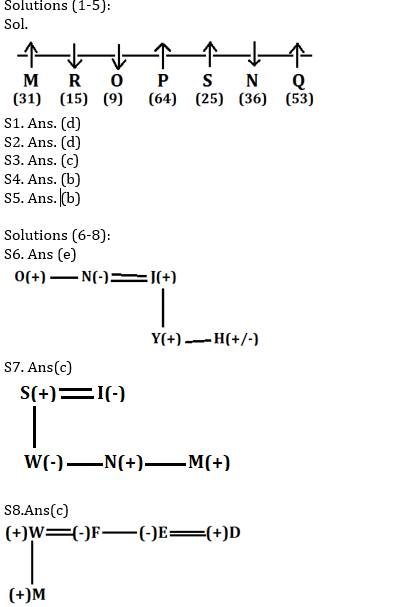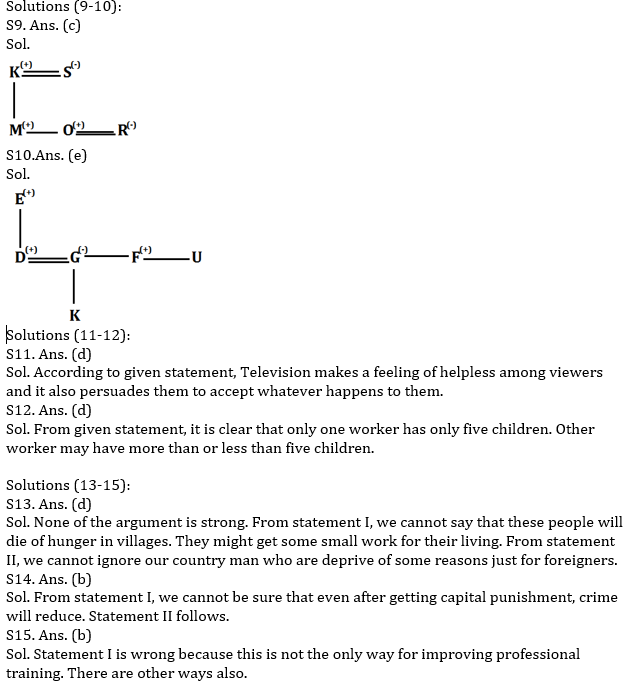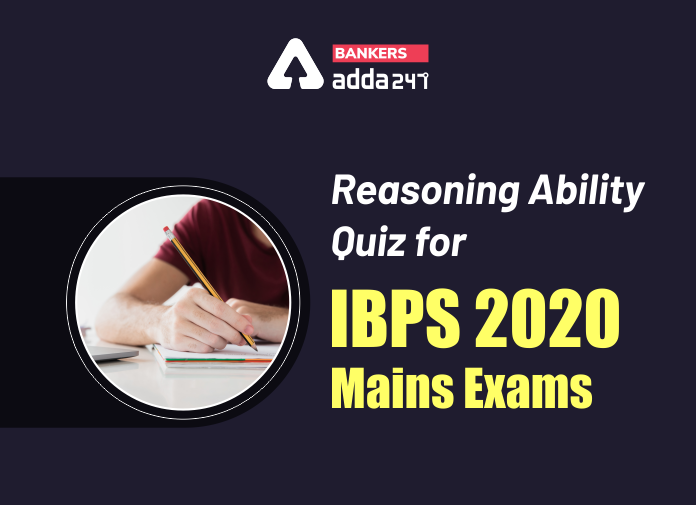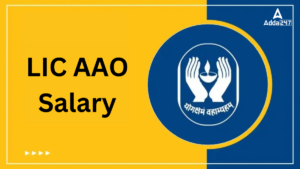Table of Contents
Directions (1-5): Study the following information carefully and answer the given questions:
Seven persons are sitting in a row, in such a way some are facing north while some are facing south. Each of them has different number of balloons- 9, 15, 25, 31, 36, 53 and 64 (but not necessary in the same order). P sits third to the right of M, who has number of balloons which is a prime number. Only one person sits between P and the one who have five balloons more than M. R sits third to the left of S, who is not an immediate neighbour of M. P does not sit at any ends and have more balloons than M and N. No one sits left of the one who has 31 balloons. The one who has 11 balloons less than P sits second to the right of S. R have less balloon than S and M. Q have number of balloons which is a prime number and sits fourth to the left of O. The one who have third lowest number of balloons facing north. R and S are facing opposite directions. O has 6 balloons less than R. P and Q are facing opposite direction of N. N face opposite direction of S.
Q1. Who among the following have lowest number of balloons?
(a) P
(b) R
(c) S
(d) O
(e) None of these
Q2. How many persons sit between M and the one who have third highest number of balloons?
(a) Two
(b) One
(c) Three
(d) More than three
(e) None
Q3. Who among the following sits second to the right of N?
(a) R
(b) Q
(c) P
(d) S
(e) None of these
Q4. What is the difference between number of balloons between M and S?
(a) 15
(b) 6
(c) 10
(d) 11
(e) None of these
Q5. Who among the following person sits second to the right of the one who have minimum number of balloons?
(a) Q
(b) M
(c) N
(d) P
(e) None of these
Directions (6-8): Each of these questions is based on the following information:
(i) P % Q means P is the father of Q.
(ii) P @ Q means P is the sister of Q.
(iii) P $ Q means P is the brother of Q.
(iv) P * Q means P is the son of Q.
(v) P # Q means P is the wife of Q.
Q6. In the expression O $ N # J % Y $ H how is H related to O?
(a) Nephew
(b) Uncle
(c) Father
(d) Niece
(e) Can’t be determined
Q7. In the expression S % W @ N $ M * I, how is I related to N?
(a) Father
(b) Son
(c) Mother
(d) Sister
(e) Can’t be determined
Q8. Which of the following symbol is used if ‘E is sister in law of W’ is true in the relation
W % M * F ___ E # D?
(a) #
(b) $
(c) @
(d) %
(e) *
Direction (9-10): In the following questions, the symbols #, &, @, * , $, % and © are used with the following meanings as illustrated below. Study the following information and answer the given questions:
P@Q- P is the child of Q
P©Q- P is the parent of Q
P%Q- P is father-in-law of Q
P&Q- P is brother-in-law of Q
P$Q- P is brother of Q
P*Q- P is wife of Q
Q9. If ‘ K©M$O@S, K%R*O’ is true, how R is related to S?
(a) Daughter
(b) Brother
(c) Daughter-in-law
(d) Sister
(e)None of these
Q10. If ‘E%G©K@D&F$U’ is true, how K is related to U?
(a)Niece
(b)Brother
(c)Nephew
(d)Son
(e)Either (a) or (c)
Directions (11-12): In each of the following questions, a statement/group of statements is given followed by some conclusions. Without resolving anything yourself, choose the conclusion which logically follows from the given statements.
Q11. Statement: Television convinces viewers that the likelihood of their becoming the victim of a violent crime is extremely high; at the same time by its very nature TV persuades viewers to passively accept whatever happens to them.
Conclusions:
(a) TV viewing promotes criminal behavior.
(b) TV viewers are most likely to be victimized than others.
(c) People should not watch TV.
(d) TV promotes a feeling of helpless vulnerability in viewers.
(e) None of these.
Q12. Statement: A factory worker has five children. No one else in the factory has five children.
Conclusions:
(a) All workers in the factory have five children each.
(b) Everybody in the factory has children.
(c) Some of the factory workers have more than five children.
(d) Only one worker in the factory has exactly five children.
(e) None of these.
Directions (13-15): In making decisions about important questions, it is desirable to be able to distinguish between ‘strong’ Arguments and ‘weak’ arguments. ‘strong’ arguments are those which are both important and directly related to the question. ‘weak’ arguments are those which are of minor important and also may not be directly related to the question or may be related to a trivial aspect of the question.
Each question below is followed by two arguments numbered I and II. You have to decide which of the argument is a ‘strong’ argument and which is a ‘weak’ argument.
Give answer (a): if only argument I is strong
Give answer (b): if only argument II is strong
Give answer (c): if either I or II is strong
Give answer (d): if neither I nor II is strong
Give answer (e): If both I and II are strong
Q13. Should all beggars on the roads in the big cities in India be forcibly sent to villages?
Arguments:
I. No, this is grossly unfair and these people will die of hunger if they are sent to villages.
II. Yes, these people create a bad impression of our country in the eyes of the foreigners who visit our country and hence should be removed.
Q14. Should all the criminals convicted for committing murder be awarded capital punishment?
Arguments:
I. Yes, this will be a significant step towards reducing cases of murder in future.
II. No, nobody has the right to take any person’s life irrespective of the acts of such individuals.
Q15. Should all the professional colleges in India be encouraged to run their own courses without affiliation to any university?
Arguments:
I. Yes, this is only way to create more opportunities for those who seek professional training.
II. No, this will dilute the quality of professional training as all such colleges may not be equipped to conduct such courses.
Practice More Questions of Reasoning for Competitive Exams:
Solutions


Download PDF of this Reasoning Quiz for IBPS Mains 2020
Practice with Crash Course and Online Test Series for IBPS Mains 2020:
- IBPS RRB PO and Clerk Prime 2020-21 Online Test Series
- IBPS PO Online test series (Prelims + Mains) 2020 by Adda247
- IBPS KA MAHAPACK Online Live Classes




 GA Capsule for SBI Clerk Mains 2025, Dow...
GA Capsule for SBI Clerk Mains 2025, Dow...
 The Hindu Review October 2022: Download ...
The Hindu Review October 2022: Download ...
 LIC AAO Salary 2025, Revised Structure, ...
LIC AAO Salary 2025, Revised Structure, ...





